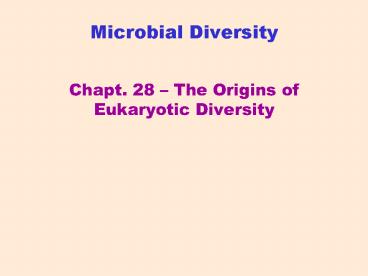Microbial Diversity - PowerPoint PPT Presentation
1 / 43
Title:
Microbial Diversity
Description:
Title: Prokaryotes and Metabolic Diversity Author: Jay Comeaux Last modified by: Kyle Harms Created Date: 2/24/2003 1:26:59 PM Document presentation format – PowerPoint PPT presentation
Number of Views:280
Avg rating:3.0/5.0
Title: Microbial Diversity
1
Microbial Diversity
- Chapt. 28 The Origins of Eukaryotic Diversity
2
What are microbes?
- Single-celled organisms and some non-cellular
parasites
3
Kinds of microbes
- Non-cellular, parasitic molecules
- Viruses
- Viroids
- Prions
- Prokaryotes
- Domain Bacteria
- Domain Archaea
- Eukaryotes
- Several Kingdoms in Domain Eukarya
4
Carl Woeses 3 Domains of Life
Based primarily on genetic sequence datae.g.,
small subunit ribosomal RNA present in all
organisms
5
Eukaryotes
- Kingdoms of Protists within the Domain Eukarya
6
Eukaryotes
- Protists
- Complex cellular structure cells with
nucleus and other organelles
7
Eukaryotic cell
Many membranous organelles
including mitochondria, which are common to all
eukaryotes
and chloroplasts (found only in
photosynthesizers)
8
Eukaryotes
- Protists
- Complex cellular structure cells with
nucleus and other organelles
E.g., cilia flagella aid motility these
cytoplasmic extensions are not homologous with
pili or flagella of prokaryotes
9
Eukaryotes
- Protists
- Complex cellular structure cells with
- nucleus and other organelles
- Nutrition Absorption, Photosynthesis, or
Ingestion
10
Eukaryotes
- Protists
- Complex cellular structure cells with
- nucleus and other organelles
- Nutrition Absorption, Photosynthesis, or
Ingestion - Reproduction mostly asexual, but some
exchange genetic material
11
Asexual cell division (mitosis)
Conjugation exchange of some genetic material
across a cytoplasmic bridge
12
Sexual reproduction via the formation and union
of gametes or other haploid cells (requires
meiosis)
Sexual, spore-forming cells of a slime mold
13
Eukaryotes
- Protists
- Complex cellular structure cells with
nucleus and other organelles - Nutrition Absorption, Photosynthesis, or
Ingestion - Reproduction mostly asexual, but some
reproduce sexually - Cysts resting stages through harsh
conditions
14
Eukaryotes
- Protists
- Arose from endosymbiosis
Compelling evidence for Lynn Margulis theory is
found in the genetic material of mitochondria
plastids
15
Eukaryotes
Ancestral prokaryote
Macroevolutionary timeline
Figure 26.13
16
Eukaryotes
Infolding of plasma membrane to form endoplasmic
reticulum and nuclear envelope
Ancestral prokaryote
Macroevolutionary timeline
Figure 26.13
17
Eukaryotes
Infolding of plasma membrane to form endoplasmic
reticulum and nuclear envelope
Ancestral prokaryote
Engulfing of heterotrophic prokaryote
Macroevolutionary timeline
Figure 26.13
18
Eukaryotes
Infolding of plasma membrane to form endoplasmic
reticulum and nuclear envelope
Ancestral prokaryote
Engulfing of heterotrophic prokaryote
Mitochondrion
Macroevolutionary timeline
Figure 26.13
19
Eukaryotes
Infolding of plasma membrane to form endoplasmic
reticulum and nuclear envelope
Engulfing of photosynthetic prokaryote
Plastid
Ancestral prokaryote
Engulfing of heterotrophic prokaryote
Mitochondrion
Macroevolutionary timeline
Figure 26.13
20
Eukaryotes
Dinoflagellates
Apicomplexans
Secondary endosymbiosis
Cyanobacterium
Ciliates
Red algae
Primary endosymbiosis
Stramenopiles
Heterotrophic eukaryote
Plastid
Euglenids
Secondary endosymbiosis
Figure 28.3
Green algae
21
Eukaryotes
Dinoflagellates
Apicomplexans
Secondary endosymbiosis
Cyanobacterium
Ciliates
Red algae
Primary endosymbiosis
Stramenopiles
Heterotrophic eukaryote
Plastid
Euglenids
Secondary endosymbiosis
Figure 28.3
Green algae
22
Eukaryotes
Dinoflagellates
Apicomplexans
Secondary endosymbiosis
Cyanobacterium
Ciliates
Red algae
Primary endosymbiosis
Stramenopiles
Heterotrophic eukaryote
Plastid
Euglenids
Secondary endosymbiosis
Figure 28.3
Green algae
23
Eukaryotes
Plastid
Dinoflagellates
Apicomplexans
Secondary endosymbiosis
Cyanobacterium
Ciliates
Red algae
Primary endosymbiosis
Stramenopiles
Heterotrophic eukaryote
Plastid
Euglenids
Secondary endosymbiosis
Figure 28.3
Green algae
24
Eukaryotes
Plastid
Dinoflagellates
Apicomplexans
Secondary endosymbiosis
Cyanobacterium
Ciliates
Red algae
Primary endosymbiosis
Stramenopiles
Heterotrophic eukaryote
Plastid
Euglenids
Secondary endosymbiosis
Figure 28.3
Green algae
25
Eukaryotes
Plastid
Dinoflagellates
Apicomplexans
Secondary endosymbiosis
Cyanobacterium
Ciliates
Red algae
Primary endosymbiosis
Stramenopiles
Heterotrophic eukaryote
Plastid
Euglenids
Secondary endosymbiosis
Figure 28.3
Green algae
26
Eukaryotes
Plastid
Dinoflagellates
Apicomplexans
Secondary endosymbiosis
Cyanobacterium
Ciliates
Red algae
Primary endosymbiosis
Stramenopiles
Heterotrophic eukaryote
Plastid
Euglenids
Secondary endosymbiosis
Figure 28.3
Green algae
Chlorarachniophytes
27
Eukaryotes
- Protists
- Arose from endosymbiosis
- Various lineages gave rise to all modern
unicellular colonial protists, as well as
all multicellular organisms (some protists, as
well as all plants, fungi, and animals)
28
Paraphyletic distribution of protists within a
tentative phylogeny of Eukarya
Choanoflagellates
Diplomonadida
Parabasala
Euglenozoa
Chlorophyta
Rhodophyta
Cercozoa
Radiolaria
Animalia
Plantae
Fungi
Alveolata
Stramenopila
Amoebozoa
Ancestral eukaryote
An ancestor and only some of its descendents
Figure 28.4
29
Hypotheses for the earliest stages of biological
diversification
Last Universal Common Ancestor
30
Hypotheses for the earliest stages of biological
diversification
31
Eukaryotes
- Protists
- Highly diverse genetically and
- phenotypically
32
Eukaryotes
- Protists
- Highly diverse genetically and
- phenotypically
- Fungus-like protists
- Heterotrophic
- Absorption
33
Eukaryotes
- Protists
- Highly diverse genetically and
- phenotypically
- Fungus-like protists
- Heterotrophic
- Decomposers
- E.g., slime molds
34
Eukaryotes
- Protists
- Highly diverse genetically and
- phenotypically
- Fungus-like protists
- Heterotrophic
- Parasitic
- E.g., water molds
35
Eukaryotes
- Protists
- Highly diverse genetically and
- phenotypically
- Plant-like protists
- Autotrophic
- Photosynthesis
36
Eukaryotes
- Protists
- Highly diverse genetically and
- phenotypically
- Plant-like protists
- Autotrophic
- Unicelluar
- E.g., Euglena
Phytoplankton (unicellular algae cyanobacteria
prokaryotes 70 of all photosynthesis)
37
Eukaryotes
- Protists
- Highly diverse genetically and
- phenotypically
- Plant-like protists
- Autotrophic
- Multicelluar
- E.g., Many
- seaweeds
38
Eukaryotes
- Protists
- Highly diverse genetically and
- phenotypically
- Animal-like protists
- Heterotrophic
- Ingestion
39
Eukaryotes
- Protists
- Highly diverse genetically and
- phenotypically
- Animal-like protists
- Heterotrophic
- Free-living
- E.g., Some amoebae
40
Eukaryotes
- Protists
- Highly diverse genetically and
- phenotypically
- Animal-like protists
- Heterotrophic
- Parasitic
- symbionts
- E.g., Giardia
41
Eukaryotes
- Protists
- Highly diverse genetically and
- phenotypically
- Animal-like protists
- Heterotrophic
- Mutualistic symbionts
- E.g., protists of termite guts
42
Eukaryotes
- Protists
- Highly diverse genetically and
- phenotypically
- Animal-like protists
- Heterotrophic
- Exhibit slightly more complex behavior
than prokaryotes
43
Predator-prey interaction between
ciliates Didinium preys upon Paramecium































